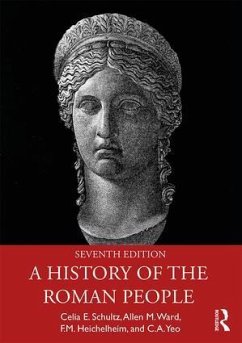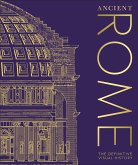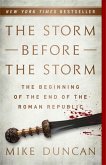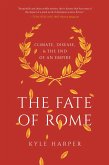- Broschiertes Buch
- Merkliste
- Auf die Merkliste
- Bewerten Bewerten
- Teilen
- Produkt teilen
- Produkterinnerung
- Produkterinnerung
A History of the Roman People offers students a comprehensive, up-to-date, readable introduction to the whole span of Roman history. Richly illustrated, this book takes readers through the mists of Roman prehistory.
Andere Kunden interessierten sich auch für
![Ancient Rome Ancient Rome]() DKAncient Rome27,10 €
DKAncient Rome27,10 €![The Storm Before the Storm The Storm Before the Storm]() Mike DuncanThe Storm Before the Storm15,48 €
Mike DuncanThe Storm Before the Storm15,48 €![Pax Pax]() Tom HollandPax12,99 €
Tom HollandPax12,99 €![Fate of Rome Fate of Rome]() Kyle HarperFate of Rome15,99 €
Kyle HarperFate of Rome15,99 €![A History of the Roman Empire in 21 Women A History of the Roman Empire in 21 Women]() Emma SouthonA History of the Roman Empire in 21 Women9,99 €
Emma SouthonA History of the Roman Empire in 21 Women9,99 €![Insane Emperors, Sunken Cities, and Earthquake Machines Insane Emperors, Sunken Cities, and Earthquake Machines]() Garrett RyanInsane Emperors, Sunken Cities, and Earthquake Machines16,99 €
Garrett RyanInsane Emperors, Sunken Cities, and Earthquake Machines16,99 €![Pox Romana Pox Romana]() Colin ElliottPox Romana29,99 €
Colin ElliottPox Romana29,99 €-
-
-
A History of the Roman People offers students a comprehensive, up-to-date, readable introduction to the whole span of Roman history. Richly illustrated, this book takes readers through the mists of Roman prehistory.
Hinweis: Dieser Artikel kann nur an eine deutsche Lieferadresse ausgeliefert werden.
Hinweis: Dieser Artikel kann nur an eine deutsche Lieferadresse ausgeliefert werden.
Produktdetails
- Produktdetails
- Verlag: Taylor & Francis Ltd
- 7 ed
- Seitenzahl: 784
- Erscheinungstermin: 13. Mai 2019
- Englisch
- Abmessung: 246mm x 174mm x 42mm
- Gewicht: 1972g
- ISBN-13: 9781138724693
- ISBN-10: 1138724696
- Artikelnr.: 55081139
- Herstellerkennzeichnung
- Libri GmbH
- Europaallee 1
- 36244 Bad Hersfeld
- gpsr@libri.de
- Verlag: Taylor & Francis Ltd
- 7 ed
- Seitenzahl: 784
- Erscheinungstermin: 13. Mai 2019
- Englisch
- Abmessung: 246mm x 174mm x 42mm
- Gewicht: 1972g
- ISBN-13: 9781138724693
- ISBN-10: 1138724696
- Artikelnr.: 55081139
- Herstellerkennzeichnung
- Libri GmbH
- Europaallee 1
- 36244 Bad Hersfeld
- gpsr@libri.de
Celia E. Schultz is Professor of Classical Studies at the University of Michigan, USA, where she is currently Director of the Interdepartmental Program in Greek and Roman History. Allen M. Ward is Emeritus Professor of History at the University of Connecticut, USA.
List of figures; Preface; Chapter 1 Roman History: Its Geographic and Human Foundations; Chapter 2 Phoenicians
Greeks
and Etruscans in Pre-Roman Italy; Chapter 3 Early Rome to 500 B.C.E.; Chapter 4 Early Roman Society
Religion
and Values; Chapter 5 From Tyrant Kings to Oligarchic Republic
509 to 287 B.C.E.; Chapter 6 The Roman Conquest of Italy and Its Impact
509 to 264 B.C.E.; Chapter 7 The First Punic War
Northern Italy
and Illyrian Pirates
264 to 219 B.C.E.; Chapter 8 War with Hannibal: The Second Punic War
218 to 201 B.C.E.; Chapter 9 Roman Imperialism East and West
200 to 133 B.C.E.; Chapter 10 The Transformation of Roman Life
264 to 133 B.C.E.; Chapter 11 The Great Cultural Synthesis
264 to 133 B.C.E.; Chapter 12 The Gracchi and the Struggle over Reforms
133 to 121 B.C.E.; Chapter 13 Destructive Rivalries
Marius
and the Social War
121 to 88 B.C.E.; Chapter 14 Civil War and Sulla's Reactionary Settlement
88 to 78 B.C.E.; Chapter 15 Personal Ambitions: The Failure of Sulla's Optimate Oligarchy
78 to 60 B.C.E.; Chapter 16 Caesar Wins and Is Lost
60 to 44 B.C.E.; Chapter 17 The Last Years of the Republic
44 to 30 B.C.E.; Chapter 18 Social
Economic
and Cultural Life in the Late Republic
ca. 133 to ca. 30 B.C.E.; Chapter 19 The Principate of the Early Roman Empire Takes Shape
29 B.C.E. to 14 C.E.; Chapter 20 Imperial Stabilization under Augustus; Chapter 21 The Impact of Augustus on Roman Imperial Life and Culture; Chapter 22 The First Two Julio-Claudian Emperors: Tiberius and Gaius (Caligula)
14 to 41 C.E.; Chapter 23 Claudius
Nero
and the End of the Julio-Claudians
41 to 68 C.E.; Chapter 24 The Crisis of the Principate and Recovery under the Flavians
69 to 96 C.E.; Chapter 25 The Five "Good" Emperors of the Second Century
96 to 180 C.E.; Chapter 26 Culture
Society
and Economy in the First Two Centuries C.E.; Chapter 27 Conflicts and Crises under Commodus and the Severi
180 to 235 C.E.; Chapter 28 The Third-Century Anarchy
235 to 285 C.E.; Chapter 29 Changes in Roman Life and Culture during the Third Century; Chapter 30 Diocletian: Creating the Fourth-Century Empire
285 to 305 C.E.; Chapter 31 Constantine the Great and Christianity
306 to 337 C.E.; Chapter 32 From Constantine's Dynasty to Theodosius the Great
337 to 395 C.E.; Chapter 33 The Evolving World of Late Antiquity in the Fourth Century C.E.; Chapter 34 Christianity and Classical Culture in the Fourth Century; Chapter 35 Germanic Takeover in the West and Imperial Survival in the East
395 to 518 C.E.; Chapter 36 Justin
Justinian
and the Impossible Dream of Universal Empire
518 to 602 C.E.; Chapter 37 The Transformation of the Late Antique Roman World
395 to 600 C.E.; Chapter 38 The Church and the Legacy of Rome
Greeks
and Etruscans in Pre-Roman Italy; Chapter 3 Early Rome to 500 B.C.E.; Chapter 4 Early Roman Society
Religion
and Values; Chapter 5 From Tyrant Kings to Oligarchic Republic
509 to 287 B.C.E.; Chapter 6 The Roman Conquest of Italy and Its Impact
509 to 264 B.C.E.; Chapter 7 The First Punic War
Northern Italy
and Illyrian Pirates
264 to 219 B.C.E.; Chapter 8 War with Hannibal: The Second Punic War
218 to 201 B.C.E.; Chapter 9 Roman Imperialism East and West
200 to 133 B.C.E.; Chapter 10 The Transformation of Roman Life
264 to 133 B.C.E.; Chapter 11 The Great Cultural Synthesis
264 to 133 B.C.E.; Chapter 12 The Gracchi and the Struggle over Reforms
133 to 121 B.C.E.; Chapter 13 Destructive Rivalries
Marius
and the Social War
121 to 88 B.C.E.; Chapter 14 Civil War and Sulla's Reactionary Settlement
88 to 78 B.C.E.; Chapter 15 Personal Ambitions: The Failure of Sulla's Optimate Oligarchy
78 to 60 B.C.E.; Chapter 16 Caesar Wins and Is Lost
60 to 44 B.C.E.; Chapter 17 The Last Years of the Republic
44 to 30 B.C.E.; Chapter 18 Social
Economic
and Cultural Life in the Late Republic
ca. 133 to ca. 30 B.C.E.; Chapter 19 The Principate of the Early Roman Empire Takes Shape
29 B.C.E. to 14 C.E.; Chapter 20 Imperial Stabilization under Augustus; Chapter 21 The Impact of Augustus on Roman Imperial Life and Culture; Chapter 22 The First Two Julio-Claudian Emperors: Tiberius and Gaius (Caligula)
14 to 41 C.E.; Chapter 23 Claudius
Nero
and the End of the Julio-Claudians
41 to 68 C.E.; Chapter 24 The Crisis of the Principate and Recovery under the Flavians
69 to 96 C.E.; Chapter 25 The Five "Good" Emperors of the Second Century
96 to 180 C.E.; Chapter 26 Culture
Society
and Economy in the First Two Centuries C.E.; Chapter 27 Conflicts and Crises under Commodus and the Severi
180 to 235 C.E.; Chapter 28 The Third-Century Anarchy
235 to 285 C.E.; Chapter 29 Changes in Roman Life and Culture during the Third Century; Chapter 30 Diocletian: Creating the Fourth-Century Empire
285 to 305 C.E.; Chapter 31 Constantine the Great and Christianity
306 to 337 C.E.; Chapter 32 From Constantine's Dynasty to Theodosius the Great
337 to 395 C.E.; Chapter 33 The Evolving World of Late Antiquity in the Fourth Century C.E.; Chapter 34 Christianity and Classical Culture in the Fourth Century; Chapter 35 Germanic Takeover in the West and Imperial Survival in the East
395 to 518 C.E.; Chapter 36 Justin
Justinian
and the Impossible Dream of Universal Empire
518 to 602 C.E.; Chapter 37 The Transformation of the Late Antique Roman World
395 to 600 C.E.; Chapter 38 The Church and the Legacy of Rome
List of figures; Preface; Chapter 1 Roman History: Its Geographic and Human Foundations; Chapter 2 Phoenicians
Greeks
and Etruscans in Pre-Roman Italy; Chapter 3 Early Rome to 500 B.C.E.; Chapter 4 Early Roman Society
Religion
and Values; Chapter 5 From Tyrant Kings to Oligarchic Republic
509 to 287 B.C.E.; Chapter 6 The Roman Conquest of Italy and Its Impact
509 to 264 B.C.E.; Chapter 7 The First Punic War
Northern Italy
and Illyrian Pirates
264 to 219 B.C.E.; Chapter 8 War with Hannibal: The Second Punic War
218 to 201 B.C.E.; Chapter 9 Roman Imperialism East and West
200 to 133 B.C.E.; Chapter 10 The Transformation of Roman Life
264 to 133 B.C.E.; Chapter 11 The Great Cultural Synthesis
264 to 133 B.C.E.; Chapter 12 The Gracchi and the Struggle over Reforms
133 to 121 B.C.E.; Chapter 13 Destructive Rivalries
Marius
and the Social War
121 to 88 B.C.E.; Chapter 14 Civil War and Sulla's Reactionary Settlement
88 to 78 B.C.E.; Chapter 15 Personal Ambitions: The Failure of Sulla's Optimate Oligarchy
78 to 60 B.C.E.; Chapter 16 Caesar Wins and Is Lost
60 to 44 B.C.E.; Chapter 17 The Last Years of the Republic
44 to 30 B.C.E.; Chapter 18 Social
Economic
and Cultural Life in the Late Republic
ca. 133 to ca. 30 B.C.E.; Chapter 19 The Principate of the Early Roman Empire Takes Shape
29 B.C.E. to 14 C.E.; Chapter 20 Imperial Stabilization under Augustus; Chapter 21 The Impact of Augustus on Roman Imperial Life and Culture; Chapter 22 The First Two Julio-Claudian Emperors: Tiberius and Gaius (Caligula)
14 to 41 C.E.; Chapter 23 Claudius
Nero
and the End of the Julio-Claudians
41 to 68 C.E.; Chapter 24 The Crisis of the Principate and Recovery under the Flavians
69 to 96 C.E.; Chapter 25 The Five "Good" Emperors of the Second Century
96 to 180 C.E.; Chapter 26 Culture
Society
and Economy in the First Two Centuries C.E.; Chapter 27 Conflicts and Crises under Commodus and the Severi
180 to 235 C.E.; Chapter 28 The Third-Century Anarchy
235 to 285 C.E.; Chapter 29 Changes in Roman Life and Culture during the Third Century; Chapter 30 Diocletian: Creating the Fourth-Century Empire
285 to 305 C.E.; Chapter 31 Constantine the Great and Christianity
306 to 337 C.E.; Chapter 32 From Constantine's Dynasty to Theodosius the Great
337 to 395 C.E.; Chapter 33 The Evolving World of Late Antiquity in the Fourth Century C.E.; Chapter 34 Christianity and Classical Culture in the Fourth Century; Chapter 35 Germanic Takeover in the West and Imperial Survival in the East
395 to 518 C.E.; Chapter 36 Justin
Justinian
and the Impossible Dream of Universal Empire
518 to 602 C.E.; Chapter 37 The Transformation of the Late Antique Roman World
395 to 600 C.E.; Chapter 38 The Church and the Legacy of Rome
Greeks
and Etruscans in Pre-Roman Italy; Chapter 3 Early Rome to 500 B.C.E.; Chapter 4 Early Roman Society
Religion
and Values; Chapter 5 From Tyrant Kings to Oligarchic Republic
509 to 287 B.C.E.; Chapter 6 The Roman Conquest of Italy and Its Impact
509 to 264 B.C.E.; Chapter 7 The First Punic War
Northern Italy
and Illyrian Pirates
264 to 219 B.C.E.; Chapter 8 War with Hannibal: The Second Punic War
218 to 201 B.C.E.; Chapter 9 Roman Imperialism East and West
200 to 133 B.C.E.; Chapter 10 The Transformation of Roman Life
264 to 133 B.C.E.; Chapter 11 The Great Cultural Synthesis
264 to 133 B.C.E.; Chapter 12 The Gracchi and the Struggle over Reforms
133 to 121 B.C.E.; Chapter 13 Destructive Rivalries
Marius
and the Social War
121 to 88 B.C.E.; Chapter 14 Civil War and Sulla's Reactionary Settlement
88 to 78 B.C.E.; Chapter 15 Personal Ambitions: The Failure of Sulla's Optimate Oligarchy
78 to 60 B.C.E.; Chapter 16 Caesar Wins and Is Lost
60 to 44 B.C.E.; Chapter 17 The Last Years of the Republic
44 to 30 B.C.E.; Chapter 18 Social
Economic
and Cultural Life in the Late Republic
ca. 133 to ca. 30 B.C.E.; Chapter 19 The Principate of the Early Roman Empire Takes Shape
29 B.C.E. to 14 C.E.; Chapter 20 Imperial Stabilization under Augustus; Chapter 21 The Impact of Augustus on Roman Imperial Life and Culture; Chapter 22 The First Two Julio-Claudian Emperors: Tiberius and Gaius (Caligula)
14 to 41 C.E.; Chapter 23 Claudius
Nero
and the End of the Julio-Claudians
41 to 68 C.E.; Chapter 24 The Crisis of the Principate and Recovery under the Flavians
69 to 96 C.E.; Chapter 25 The Five "Good" Emperors of the Second Century
96 to 180 C.E.; Chapter 26 Culture
Society
and Economy in the First Two Centuries C.E.; Chapter 27 Conflicts and Crises under Commodus and the Severi
180 to 235 C.E.; Chapter 28 The Third-Century Anarchy
235 to 285 C.E.; Chapter 29 Changes in Roman Life and Culture during the Third Century; Chapter 30 Diocletian: Creating the Fourth-Century Empire
285 to 305 C.E.; Chapter 31 Constantine the Great and Christianity
306 to 337 C.E.; Chapter 32 From Constantine's Dynasty to Theodosius the Great
337 to 395 C.E.; Chapter 33 The Evolving World of Late Antiquity in the Fourth Century C.E.; Chapter 34 Christianity and Classical Culture in the Fourth Century; Chapter 35 Germanic Takeover in the West and Imperial Survival in the East
395 to 518 C.E.; Chapter 36 Justin
Justinian
and the Impossible Dream of Universal Empire
518 to 602 C.E.; Chapter 37 The Transformation of the Late Antique Roman World
395 to 600 C.E.; Chapter 38 The Church and the Legacy of Rome









